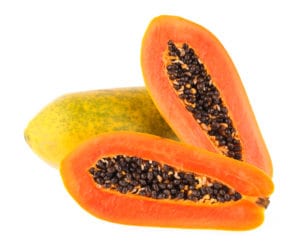Written by Joyce Smith, BS. Patients with dengue fever who supplemented with Carica papaya juice had a significant increase in platelet count compared to the control.
 Carica papaya is one of the 12000 Malyaian flowering plants of which 1300 have medicinal properties.1 Recent studies have demonstrated papaya’s antioxidant 2, anti-inflammatory 3 and wound healing properties 4 as well as its’ antitumor and immunemodulatory effects 5.
Carica papaya is one of the 12000 Malyaian flowering plants of which 1300 have medicinal properties.1 Recent studies have demonstrated papaya’s antioxidant 2, anti-inflammatory 3 and wound healing properties 4 as well as its’ antitumor and immunemodulatory effects 5.
Dengue fever (DF) and dengue hemorrhagic fever (DHF) is a systemic viral infection transmitted between humans by the Aedes aegypti mosquitoe and has no effective treatment or cure. It is endemic in Malaysia, an upper middle income Asian country of 30 million people. The country recorded an average of 48,000 reported dengue cases and 102 dengue deaths annually between 2010 and 2014 6.
The febrile phase of this DH is characterized by high fever and the development of thrombocytopenia (insufficient platelets) that can lead to bleeding, shock, and death. An increase in the activity of certain genes, namely the Arachidonate 12-lipoxygenase (ALOX 12) and the Platelet-Activating Factor Receptor (PTAFR) genes are necessary for platelet production to occur. Since Carica papaya leave juice (CPLJ) may have platelet activation properties, researchers conducted this open labeled randomized controlled trial 7 to investigate and validate the traditional claim that Carica papaya leave juice (CPLJ) can increase the platelet count in patients with dengue fever (DF).
Approximately half of the 290 participating patients with DF and DHF, received the juice from 50 grams of Carica papya leaves, once daily for three consecutive days along with standard care (n=145) while the control group (n=145) received only standard care. All patients’ blood count was monitored every 8 hours for 48 hours. Gene expression studies were conducted on the ALOX 12 and PTAFR genes. The mean increase in platelet counts were compared in both intervention and placebo groups using repeated measure ANCOVA.
- Forty hours after the first dose, researchers found a significant increased mean platelet count in the intervention group (P<0.001) but not in the control group.
- When comparing the mean platelet count between intervention and control groups, the mean platelet count of the intervention group was significantly higher than that of the control group after 40 and 48 hours of admission. (P<0.01 ).
- The ALOX 12 (FC = 15.00) and PTAFR (FC = 13.42) genes were highly expressed among those patients on the papaya leaf juice. The ALOX 12 gene and the PTAFR gene, known to be responsible for increased platelet production and aggregation, demonstrated a15.00-fold and 13.42-fold increase in gene activity among the patients who consumed the juice as compared to the control group, thus indicating that the juice had played an important role in arresting the bleeding tendencies among these patients.
The administration of CPLJ in DF and DHF was safe, induced a rapid increase in platelet count and could therefore potentially play a valuable role in the management of DF in the near future.
Hopefully in the near future large-scale studies in DF confirmed patients will be conducted in a tertiary hospital set up to standardize dosage and length of treatment with Carica papaya leaf.
Source: Subenthiran, Soobitha, Tan Chwee Choon, Kee Chee Cheong, Ravindran Thayan, Mok Boon Teck, Prem Kumar Muniandy, Adlin Afzan, Noor Rain Abdullah, and Zakiah Ismail. “Carica papaya leaves juice significantly accelerates the rate of increase in platelet count among patients with dengue fever and dengue haemorrhagic fever.” Evidence-Based Complementary and Alternative Medicine 2013 (2013).
Copyright © 2013 Soobitha Subenthiran et al. This is an open access article distributed under the Creative Commons Attribution License, which permits unrestricted use, distribution, and reproduction in any medium, provided the original work is properly cited.
Click here to read the full text study.
Posted November 13, 2017.
Joyce Smith, BS, is a degreed laboratory technologist. She received her bachelor of arts with a major in Chemistry and a minor in Biology from the University of Saskatchewan and her internship through the University of Saskatchewan College of Medicine and the Royal University Hospital in Saskatoon, Saskatchewan. She currently resides in Bloomingdale, IL.
References:
- Burkill IH. A dictionary of the economic products of the Malay Peninsula. 2015.
- Imaga NA, Gbenle GO, Okochi VI, et al. Phytochemical and antioxidant nutrient constituents of Carica papaya and Parquetina nigrescens extracts. Scientific research and essays. 2010;5(16):2201-2205.
- Owoyele BV, Adebukola OM, Funmilayo AA, Soladoye AO. Anti-inflammatory activities of ethanolic extract of Carica papaya leaves. Inflammopharmacology. 2008;16(4):168-173.
- Gurung S, Škalko-Basnet N. Wound healing properties of Carica papaya latex: in vivo evaluation in mice burn model. Journal of Ethnopharmacology. 2009;121(2):338-341.
- Otsuki N, Dang NH, Kumagai E, Kondo A, Iwata S, Morimoto C. Aqueous extract of Carica papaya leaves exhibits anti-tumor activity and immunomodulatory effects. Journal of Ethnopharmacology. 2010;127(3):760-767.
- Packierisamy PR, Ng C-W, Dahlui M, et al. Cost of dengue vector control activities in Malaysia. The American journal of tropical medicine and hygiene. 2015;93(5):1020-1027.
- Subenthiran S, Choon TC, Cheong KC, et al. Carica papaya leaves juice significantly accelerates the rate of increase in platelet count among patients with dengue fever and dengue haemorrhagic fever. Evidence-Based Complementary and Alternative Medicine. 2013;2013.
